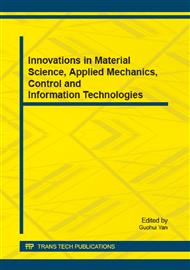[1]
M. Athans, P. L. Falb, R. T. Lacoss, Time-, Fuel-, and energy optimal control of nonlinear norm-Invariant systems", IEEE Trans. on Automatic Control, Vol. 8, Issue 3, July 1963, pp.: 196 – 202.
DOI: 10.1109/tac.1963.1105581
Google Scholar
[2]
B. Bose, Energy, environment and advances in power electronics, IEEE Trans. on Power Electronics, Vol. 15, No. 4, July 2000, pp.: 688 – 701.
DOI: 10.1109/63.849039
Google Scholar
[3]
A. Isidori, Nonlinear Control Systems, London: Springer-Verlag Berlin, 2001. ISBN 3-5400-19916-3rd edition.
Google Scholar
[4]
H. Yu, J. Hou, Z. Zou, Position control of PMSM based on energy-shaping and MTPA principles, Proc. World Congress on intelligent control and automation, Chongqing, China, 2008, pp.6532-6536.
DOI: 10.1109/wcica.2008.4594569
Google Scholar
[5]
S. Brock, T. Pajchrowski, Reducing energy losses for fan applications with V/f control of PMSM, Przeglad Elektrotechniczny, vol. 87, 2011, pp.: 89-94.
Google Scholar
[6]
M. A. Sheta, V. Agarwal, P. S. V. Nataraj, A new energy optimal control scheme for a separately excited dc motor based incremental motion, International Journal of Automation and Computing, August 2006, pp.: 267-276.
DOI: 10.1007/s11633-009-0267-4
Google Scholar
[7]
S. J. Dodds, G. Sooriyakumar, R. Perryman, Sliding mode minimum energy position controller for permanent magnet synchronous motor drives, in WSEAS Trans. on Systems and Control, vol. 3, issue 4, 2008, pp.299-309.
Google Scholar
[8]
J. Vittek, P. Bris, Energy saving position control algorithms for PMSM drives with Coulomb and viscous friction, Proc. of IEEE ICCA conf., June 22013, Hangzhou, China, pp.: 1485-1490.
DOI: 10.1109/icca.2013.6564977
Google Scholar
[9]
J. Vittek, P. Bris, Z. Biel, M. Hrkel, Energy saving position control algorithms for PMSM drives with quadratic friction, Proc. of IEEE Africon conf., Sept. 2013, Mauritius, pp.: 1001-1006.
DOI: 10.1109/afrcon.2013.6757854
Google Scholar
[10]
I. Bivol, C. Vasilache, "The application of Euler – Lagrange method of optimization for electromechanical motion control. The Annals of Dunarea de Joss University of Galati, vol. 3, pp.5-11.
Google Scholar
[11]
G. Manolea, Loss-function optimal control of the positioning servomotors with static torque proportional to the speed, " Proc. of 7th Int. Workshop on Advanced Motion Control, AMC, 02, Maribor, Slovenia, July 2002, pp.: 232-235.
DOI: 10.1109/amc.2002.1026922
Google Scholar
[12]
J. Vittek, and S. J. Dodds, Forced dynamics control of electric drives, EDIS Publishing Centre of Zilina University, Slovakia, 2003, available at http: /www. kves. uniza. sk/ (e-learning).
Google Scholar
[13]
S. J. Dodds, Settling time formulae for the design of control systems with linear closed loop dynamics, in Proc. of the International conference AC&T - Advances in Computing and Technology, University of East London, UK, (2007).
Google Scholar
[14]
D. W. Novotny, T. A. Lipo, Vector control and dynamics of AC drives, Clarendon Press, (1996).
Google Scholar
[15]
P. Brandstetter, T. Krecek, Speed and current control of permanent magnet synchronous motor using IMC controllers, Advances in Electrical and Computer Engineering, Vol. 12, Issue 4, 2012, pp.: 3-10.
DOI: 10.4316/aece.2012.04001
Google Scholar
[16]
Y. Zhu, X. Zhu, T. Izumi, M. Kanesaka, Optimal velocity function minimizing dissipated energy considering all friction in a position control system, Journal of Robotics and Mechatronics, vol. 10, , Jan. 2007, pp.: 97-105.
DOI: 10.20965/jrm.2007.p0097
Google Scholar
[17]
K. K. Shyu, Ch. K Lai, , Y. W Tsai, D. I. Yang, A newly robust controller design for the position control of permanent-magnet synchronous motor, IEEE Trans. on Industrial Electronics, vol. 49, No. 3, June 2002, pp.: 558-565.
DOI: 10.1109/tie.2002.1005380
Google Scholar
[18]
Y. Wang, K. Ueda, S. A. Bortoff, A Hamiltonian approach to compute an energy efficient trajectory for a servomotor system, Automatica, Vol. 49, No. 12, Dec. 2013, pp.3550-3561.
DOI: 10.1016/j.automatica.2013.09.019
Google Scholar
[19]
T. Duda, A. Vitecek, Robust control algorithms and the state variable aggregation method, Proc. 2013 14th International Carpathian Control Conference, ICCC 2013, Rytro; Poland; May 2013, pp.: 49-52.
DOI: 10.1109/carpathiancc.2013.6560509
Google Scholar
[20]
K. Kyslan, F. Ďurovský, Dynamic emulation of mechanical loads - An approach based on industrial drives' features, Automatika, Vol. 54, No. 3, 2013, pp.: 356-363.
DOI: 10.7305/automatika.54-3.184
Google Scholar
[21]
L. M. Grzesiak, T. Tarczewski, PMSM servo-drive control system with a state feedback and a load torque feedforward compensation, COMPEL, The Int. Journal for Computation and Mathematics in Electrical and Electronic Engineering, 2013, Vol. 32, No. 1, pp.: 364-382.
DOI: 10.1108/03321641311293939
Google Scholar


